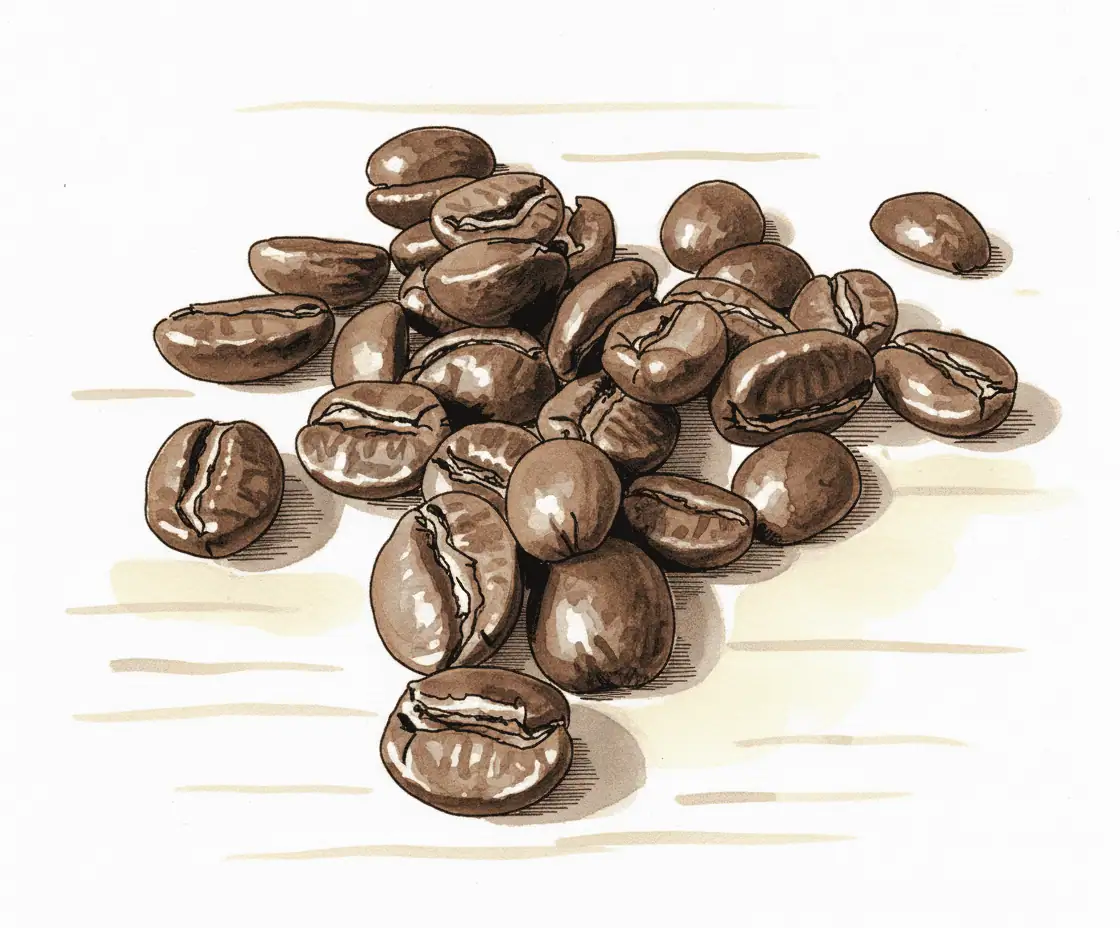Average altitude
Mid altitudes (around 1200–1500 meters) produce beans that offer a balance between sweetness and acidity. Growing conditions are still mild, yet the beans often develop more refinement than at lower elevations. This results in a brighter flavor profile, sometimes with subtle fruit or floral notes. Mid-altitude regions are common in countries such as Colombia, Mexico, and parts of Central America.
Beans

Peru
Peruaanse Arabica uit hooglandregio’s zoals Junin en Cusco, geteeld op duizend tot achttienhonderd meter, levert een heldere kop met tonen van cacao, nootmuskaat en walnoot. De medium roast maakt het profiel rond en soepel, geschikt voor filter, espresso, percolator en French press. De bonen worden gewassen voor een zuivere smaak en milde zuurgraad. Variëteiten zijn…

Peru Amazonas (Future Proof)
Peru Amazonas Future Proof is een single origin uit Namballe in Cajamarca, afkomstig van kleinschalige koffieboeren op 1150 tot 1650 meter. De bonen worden gewassen verwerkt en wekelijks vers gebrand voor optimale frisheid. Verwacht een zachte, romige body met tonen van melkchocolade, noten, honing, kers en amandel, met een heldere zuurgraad. Caturra en Typica zorgen…

Peru Finca Churupampa basic 83+ – Direct Trade – vers gebrand – 1000 gram
Peru Finca Churupampa is een traceerbare blend uit Chirinos in Cajamarca. De koffie wordt verbouwd door boeren die training en cupping ondersteuning krijgen. Het brandprofiel is medium met Tonino 92, wat zorgt voor balans tussen helderheid en body. In de kop komen tonen van rode appel, honing, chocolade en een vleugje bruine suiker en citrus…

Robusta Malaria Free World Project – Uganda
Robusta Malaria Free World komt uit Uganda, een topproducent van Robusta. Het initiatief werkt met Buy One Give One, voor elke 12 kilo specialtykoffie wordt een muskietennet geschonken aan telers. De koffie biedt een volle body, lage zuurgraad en smaken van chocolade, karamel, noten en tropisch fruit. Meestal natuurlijk gedroogd, wat zoete en aardse tonen…

Salvador Gourmet
Salvador Gourmet is een 100 procent Arabica uit El Salvador, geteeld op 800 tot 1 200 meter op vulkanische bodems met vochtige Pacifische lucht. De oogst is handmatig van oktober tot januari. Na 24 uur fermentatie in de gewassen methode worden de bonen volledig in de zon gedroogd en machinaal gescreend. Het resultaat is een…

Sironko
Deze post verkent Sironko uit de regio Mount Elgon in Oeganda, een koffie met natuurlijke of anaerobe verwerking en soms barrel fermentatie. De bessen komen van kleine boeren, met strenge selectie en langzame droging. Smaaktonen variëren van limoen, framboos en cola tot kers, praline en marsepein. De branding is meestal medium, geschikt voor espresso en…

Slowzilla
Slowzilla is een klassieke espressobranding uit Brazilië, geroosterd voor een volle, zachte kop met tonen van karamel, chocolade, steenfruit en noten. De bonen komen van Fazenda Fronteira in Socorro, op 1350 meter, waar boerin Ellen Fontana werkt met bosbehoud en minimale interventie. Natural verwerking versterkt zoetheid en complexiteit. De blend bestaat uit Yellow Catuaí, Mundo…

Viani
Viani is een Colombiaanse koffie uit Cundinamarca, geleverd door meer dan vierhonderd kleine boeren. De bessen groeien op 1300 tot 1800 meter en worden gewassen verwerkt, met fermentatie van circa 12 tot 14 uur en droging op verhoogde bedden of mechanisch. De smaak is klassiek en krachtig met milde zuurgraad, tonen van steenfruit, cacao en…

West Friesche Brand
West Friesche Brand is een karaktervolle blend met West-Friese roots, gebrand in Enkhuizen. De 100 procent Arabica bonen komen uit Brazilië, Colombia, Guatemala en Indonesië. Medium roast met volle body en tonen van chocolade, karamel, vanille, amandel, hazelnoot en een kruidige toets. Dagelijks vers gebrand op duurzame Loring-branders, met hersluitbare verpakking voor optimale versheid. Veelzijdig…
Mid-Altitudes (around 1200–1500 meters)
Looking for a beautiful balance between sweetness and acidity in the cup? Then beans from mid-altitude regions are a great choice. These areas are common in countries like Colombia, Mexico, and parts of Central America. Here you get the best of both worlds: enough coolness for a refined taste, yet enough warmth for good sugar development.
How altitude affects espresso flavor
At elevations of roughly 1200 to 1500 meters, coffee cherries still ripen more slowly than at sea level, but not as slowly as at very high altitudes. This creates a balanced espresso: a mildly sweet base, often with subtle fruity or floral hints, alongside a pleasant, not overly dominant acidity. These coffees are known for their approachable yet refined character. They are often ideal for those who enjoy an espresso with a clear flavor, but without the sometimes “sharp” edge of very high-grown beans.
Chemical composition: balance of sugars and acids
Mid altitudes still give the coffee plant enough coolness to build complexity, yet enough warmth to encourage sweeter notes. The beans generally have a slightly lower density than true high-grown beans, but remain firm enough to develop a wide flavor palette. You will notice the acids are a touch less pronounced, allowing the sweetness to come forward. This can yield a balanced cup of espresso with both freshness and a soft body.
Processing methods: diversity is key
In many regions at these elevations, there is active experimentation with different processing methods. The washed method remains popular, but honey and semi-washed processes are also often used, depending on local traditions and the desired flavor profiles. Thanks to slightly higher temperatures (compared to high mountains), sun-drying beans is often easier. This allows farmers to apply natural or pulped natural methods, which in turn leads to more sweetness and sometimes a hint of fermentation in the taste.
Climate and microclimate
At 1,200 to 1,500 meters, conditions usually mean mild temperatures, regular rainfall, and still plenty of sun. This kind of environment is ideal for coffee shrubs. They are protected from extreme heat, but also from the cold of great heights. As a result, the growing season is stable and fairly predictable. Microclimates arise from local variations in rainfall and hours of sunshine. A shrub on one mountainside can therefore produce slightly different flavor nuances than one on the slope next to it.
Yield and resilience
In general, the yield here is better than at very high elevations, because the plants are less stressed by colder nights or thin air. This means farmers can often produce slightly higher volumes while quality remains high. Moreover, the shrubs can often stay healthy for longer, provided they are well maintained. A stable yield is beneficial for the local community, as farmers’ income is less dependent on erratic harvests.
Choosing coffee varieties
In this altitude band, many Arabica varieties are found, such as Caturra, Colombia, and Bourbon. Farmers often choose plants that strike a good balance between yield and flavor. Some varieties are resistant to diseases like "coffee leaf rust", which is an important factor in areas with higher humidity. This allows farmers to grow with confidence, knowing they will harvest consistently tasty coffee.
Coffee from mid-altitudes is therefore highly recommended for anyone seeking a balanced espresso. Expect subtle fruit or floral notes, complemented by a mildly sweet body. No sharp extremes, but a rich, approachable flavor that many drinkers appreciate.
A selection for those who are open to a lively and complex coffee experience.
